![]()
![]()
![]()
Use LEFT and RIGHT arrow keys to navigate between flashcards;
Use UP and DOWN arrow keys to flip the card;
H to show hint;
A reads text to speech;
57 Cards in this Set
- Front
- Back
|
Density altitude increases with a. an increase in temperature only. b. increases in pressure, temperature, and moisture content of the air. c. increases in temperature and moisture content of the air, and a decrease in pressure. |
c. increases in temperature and moisture content of the air, and a decrease in pressure. |
|
|
What would increase the density altitude at a given airport? a. An increase in air temperature. b. A decrease in relative humidity. c. An increase in atmospheric pressure. |
a. An increase in air temperature. |
|
|
As altitude increases, the indicated airspeed at which a given airplane stalls in a particular configuration will a. remain the same as at low altitude. b. decrease as the true airspeed increases. c. increase because the air density decreases. |
a. remain the same as at low altitude. |
|
|
Density altitude may be determined by correcting a. true altitude for nonstandard temperature. b. pressure altitude for nonstandard temperature. c. indicated altitude for temperature variations. |
b. pressure altitude for nonstandard temperature. |
|

Determine the density altitude. Airport elevation: 5,515 ft OAT: 30°C Altimeter setting: 29.40" Hg a. 6,000 feet. b. 8,450 feet. c. 9,100 feet. |
c. 9,100 feet. |
|
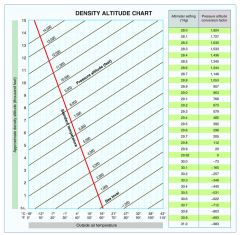
Determine the density altitude. Airport elevation: 3,795 ft OAT: 24°C Altimeter setting: 29.70" Hg a. 5,700 feet. b. 5,900 feet. c. 4,000 feet. |
b. 5,900 feet. |
|

Determine the density altitude. Airport elevation: 3,450 ft OAT: 35°C Altimeter setting: 30.40" Hg a. 3,400 feet. b. 6,650 feet. c. 5,950 feet. |
c. 5,950 feet. |
|
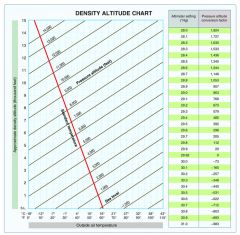
What is the effect of a temperature increase from 30 to 50°F on the density altitude if the pressure altitude remains at 3,000 feet MSL? a. 900-foot increase. b. 1,100-foot decrease. c. 1,300-foot increase. |
c. 1,300-foot increase. |
|
|
Determine the pressure altitude at an airport that is 3,563 feet MSL with an altimeter setting of 29.96. a. 3,527 feet MSL. b. 3,556 feet MSL. c. 3,639 feet MSL. |
a. 3,527 feet MSL. |
|
|
Under what condition is indicated altitude the same as true altitude? a. If the altimeter has no mechanical error. b. When at sea level under standard conditions. c. When at 18,000 feet MSL with the altimeter set at 29.92. |
b. When at sea level under standard conditions. |
|
|
What is true altitude? a. The vertical distance of the aircraft above sea level. b. The vertical distance of the aircraft above the surface. c. The height above the standard datum plane. |
a. The vertical distance of the aircraft above sea level. |
|
|
What is absolute altitude? a. The altitude read directly from the altimeter. b. The vertical distance of the aircraft above the surface. c. The height above the standard datum plane. |
b. The vertical distance of the aircraft above the surface. |
|
|
An altimeter indicates 1,850 feet MSL when set to 30.18. What is the approximate pressure altitude? a. 1,590 feet. b. 1,824 feet. c. 2,110 feet. |
a. 1,590 feet. |
|
|
If the atmospheric pressure and temperature remain the same, how would an increase in humidity affect takeoff performance? a. Longer takeoff distance; the air is more dense. b. Longer takeoff distance; the air is less dense. c. Shorter takeoff distance; the air is more dense. |
b. Longer takeoff distance; the air is less dense. |
|
|
How does increased weight affect the takeoff distance of an airplane? a. The airplane will accelerate more slowly with the same power output, but the same airspeed is required to generate necessary lift for takeoff. b. The airplane will accelerate more slowly with the same power output, and a higher airspeed is required to generate necessary lift for takeoff. c. Every airplane has the same acceleration factor with the same power output, but a higher airspeed is needed to overcome the increased ground effect. |
b. The airplane will accelerate more slowly with the same power output, and a higher airspeed is required to generate necessary lift for takeoff. |
|
|
Which statement is true regarding takeoff performance with high density altitude conditions? a. The acceleration rate will increase since the lighter air creates less drag. b. The acceleration rate is slower because the engine and propeller efficiency is reduced. c. A higher-than-normal indicated airspeed is required to produce sufficient lift since the air is less dense. |
b. The acceleration rate is slower because the engine and propeller efficiency is reduced. |
|
|
What effect does an uphill runway slope have upon takeoff performance? a. Decreases takeoff speed. b. Increases takeoff distance. c. Decreases takeoff distance. |
b. Increases takeoff distance. |
|

Determine the takeoff distance required to clear a 50-foot obstacle. Temperature: 3°C Pressure altitude: 6,000 ft Weight: 3,000 lb Headwind: 15 kts a. 1,464 feet. b. 1,215 feet. c. 1,331 feet. |
c. 1,331 feet. |
|

Determine the ground roll required for takeoff. Temperature: 24°C Pressure altitude: 2,500 ft Weight: 2,400 lb Headwind: 25 kts a. 256 feet. b. 370 feet. c. 230 feet. |
c. 230 feet. |
|

Determine the ground roll required for takeoff. Temperature: 25°C Pressure altitude: 2,000 ft Weight: 2,200 lb Headwind: 15 kts a. 205 feet. b. 261 feet. c. 237 feet. |
b. 261 feet. |
|

Determine the takeoff distance required to clear a 50-foot obstacle. Temperature: 23°C Pressure altitude: 3,000 ft Weight: 2,400 lb Headwind: 15 kts a. 754 feet. b. 718 feet. c. 653 feet. |
b. 718 feet. |
|
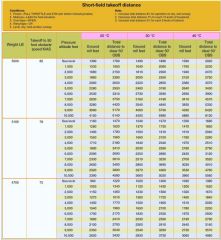
Determine the approximate total distance required to clear a 50-foot obstacle. Temperature: 20°C Pressure altitude: 1,000 ft Surface: sod Weight: 5,300 lb Wind: 15 kts headwind a. 1,724 feet. b. 1,816 feet. c. 2,061 feet. |
a. 1,724 feet. |
|
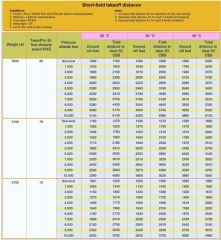
Determine the approximate total distance required to clear a 50-foot obstacle. Temperature: 35°C Pressure altitude: 3,000 ft Surface: sod Weight: 5,100 lb Wind: 20 kts headwind a. 1,969 feet. b. 2,023 feet. c. 2,289 feet. |
b. 2,023 feet. |
|
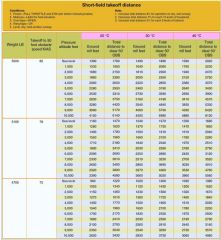
Determine the approximate total distance required to clear a 50-foot obstacle. Temperature: 25°C Pressure altitude: 2,500 ft Surface: asphalt Weight: 5,500 lb Wind: 2 kts tailwind a. 2,228 feet. b. 2,294 feet. c. 2,462 feet. |
c. 2,462 feet. |
|

The indicated airspeed that would give the greatest gain in altitude in a unit of time at 3,200 feet is determined to be a. 93 KIAS. b. 94 KIAS. c. 112 KIAS. |
c. 112 KIAS. |
|
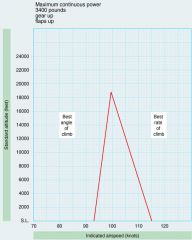
What indicated airspeed at 3,000 feet would result in the greatest increase in altitude for a given distance? a. 94 KIAS. b. 113 KIAS. c. 115 KIAS. |
a. 94 KIAS. |
|
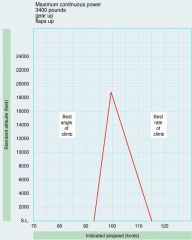
To maintain the best rate of climb, the indicated speed should be a. maintained at a constant value during the climb. b. adjusted to maintain the specified rate of climb. c. reduced approximately .8 knots per 1,000 feet of altitude. |
c. reduced approximately .8 knots per 1,000 feet of altitude. |
|
|
An aircraft is flying at a constant power setting and constant indicated altitude. If the outside air temperature (OAT) decreases, true airspeed will a. decrease and true altitude will decrease. b. increase and true altitude will increase. c. increase and true altitude will decrease. |
a. decrease and true altitude will decrease. |
|
|
An aircraft is flying at a constant power setting and constant indicated altitude. If the outside air temperature (OAT) increases, true airspeed will a. increase and true altitude will decrease. b. increase and true altitude will increase. c. decrease and true altitude will increase. |
b. increase and true altitude will increase. |
|
|
As density altitude increases, which will occur if a constant indicated airspeed is maintained in a no-wind condition? a. True airspeed increases; groundspeed decreases. b. True airspeed decreases; groundspeed decreases. c. True airspeed increases; groundspeed increases. |
c. True airspeed increases; groundspeed increases. |
|
|
In a propeller-driven airplane, maximum range occurs at a. minimum drag required. b. minimum power required. c. maximum lift/drag ratio. |
c. maximum lift/drag ratio. |
|
|
The critical engine on most light multiengine airplanes with clockwise rotating propellers is the a. left engine, because of the P-factor of the left propeller. b. right engine, because of the P-factor of the left propeller. c. left engine, because of the P-factor of the right propeller. |
c. left engine, because of the P-factor of the right propeller. |
|
|
On a multiengine airplane with engines which rotate clockwise, the critical engine is the a. left engine, because the right engine center of thrust is closer to the centerline of the fuselage. b. right engine, because the left engine center of thrust is closer to the centerline of the fuselage. c. left engine, because the right engine center of thrust is farther away from the centerline of the fuselage. |
c. left engine, because the right engine center of thrust is farther away from the centerline of the fuselage. |
|
|
What is the significance of the blue radial line on the airspeed indicator of a light multiengine airplane and when is it to be used? It indicates the a. minimum speed at which the airplane is controllable when the critical engine is suddenly made inoperative and should be used at all altitudes when an engine is inoperative. b. speed which will provide the maximum altitude gain in a given time when one engine is inoperative and should be used for climb and final approach during engine-out operations. c. speed which will provide the greatest height for a given distance of forward travel when one engine is inoperative and should be used for all climbs during engine-out operations. |
b. speed which will provide the maximum altitude gain in a given time when one engine is inoperative and should be used for climb and final approach during engine-out operations. |
|
|
On a multiengine airplane, where the propellers rotate in the same direction, why is the loss of power on one engine more critical than the loss of power on the other engine? a. The corkscrew pattern of airflow from one propeller is less effective against the airflow from the critical engine. b. The torque reaction from operation of the critical engine is more severe around the vertical axis as well as the longitudinal axis. c. The asymmetric propeller thrust or P-factor results in the center of thrust from one engine being farther from the airplane centerline than the center of thrust from the other engine. |
c. The asymmetric propeller thrust or P-factor results in the center of thrust from one engine being farther from the airplane centerline than the center of thrust from the other engine. |
|
|
For an airplane with reciprocating, nonturbo-charged engines, Vmc a. decreases with altitude. b. increases with altitude. c. is not affected by altitude. |
a. decreases with altitude. |
|
|
When one engine fails on a twin-engine airplane, the resulting performance loss a. may reduce the rate of climb by 80 percent or more. b. reduces cruise indicated airspeed by 50 percent or more. c. is approximately 50 percent since 50 percent of the normally available thrust is lost. |
a. may reduce the rate of climb by 80 percent or more. |
|
|
When operating a light multiengine airplane at Vmc, the pilot should expect performance to be sufficient to maintain a. heading. b. heading and altitude. c. heading, altitude, and be able to climb at 50 feet per minute. |
a. heading. |
|
|
Which is true regarding the operation of a multiengine airplane with one engine inoperative? a. Banking toward the operating engine increases Vmc. b. Banking toward the inoperative engine increases Vmc. c. Vmc is a designed performance factor which must be proven during type certification and will not change as long as the ball is centered with appropriate rudder pressure. |
b. Banking toward the inoperative engine increases Vmc. |
|
|
In a twin-engine airplane, the single-engine service ceiling is the maximum density altitude at which Vyse will produce a. 50 feet per minute rate of climb. b. 100 feet per minute rate of climb. c. 500 feet per minute rate of climb. |
a. 50 feet per minute rate of climb. |
|
|
Which condition causes Vmc to be the highest? a. CG is at the most forward allowable position. b. CG is at the most rearward allowable position. c. Gross weight is at the maximum allowable value. |
b. CG is at the most rearward allowable position. |
|
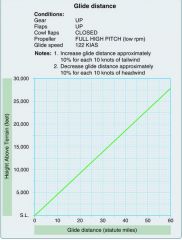
What is the approximate glide distance? Height above terrain: 5,500 ft Tailwind: 10 kts a. 11 miles. b. 12 miles. c. 13 miles. |
c. 13 miles. |
|
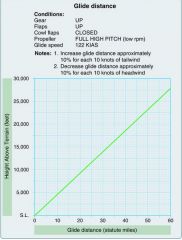
What is the approximate glide distance? Height above terrain: 7,500 ft Headwind: 30 kts a. 11.5 miles. b. 16.5 miles. c. 21.5 miles. |
a. 11.5 miles. |
|
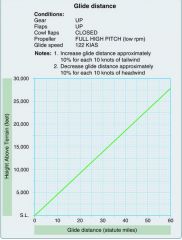
What is the approximate glide distance? Height above terrain: 10,500 ft Tailwind: 20 kts a. 24 miles. b. 26 miles. c. 28 miles. |
c. 28 miles. |
|
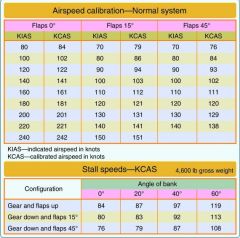
What would be the indicated stall speed in a 30° banked turn with the gear down and flaps set at 15°? a. 77 KIAS. b. 82 KIAS. c. 88 KIAS. |
b. 82 KIAS. |
|
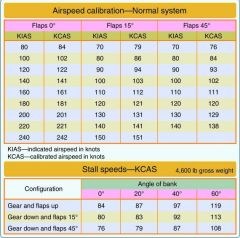
What would be the indicated stall speed in a 60° banked turn with the gear and flaps up? a. 110 KIAS. b. 117 KIAS. c. 121 KIAS. |
b. 117 KIAS. |
|

What would be the indicated stall speed during a 40° banked turn with the gear down and flaps set at 45°? a. 81 KIAS. b. 83 KIAS. c. 89 KIAS. |
b. 83 KIAS. |
|
|
What can a pilot expect when landing at an airport located in the mountains? a. Higher true airspeed and longer landing distance. b. Higher indicated airspeed and shorter landing distance. c. Lower true airspeed and longer landing distance. |
a. Higher true airspeed and longer landing distance. |
|

What is the total landing distance over a 50-foot obstacle? Temperature: 15°C Pressure altitude: 4,000 ft Weight: 3,000 lb Headwind: 22 kts a. 1,250 feet. b. 1,175 feet. c. 1,050 feet. |
b. 1,175 feet. |
|
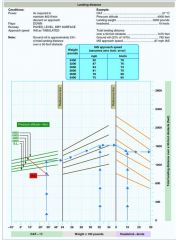
Determine the approximate ground roll. Temperature: 33°C Pressure altitude: 6,000 ft Weight: 2,800 lb Headwind: 14 kts a. 742 feet. b. 1,280 feet. c. 1,480 feet. |
a. 742 feet. |
|
|
What is the total landing distance over a 50-foot obstacle? Temperature: 35°C Pressure altitude: 2,000 ft Weight: 3,400 lb Headwind: 10 kts a. 1,650 feet. b. 1,575 feet. c. 1,475 feet. |
c. 1,475 feet. |
|
|
Determine the approximate crosswind component. Landing: Rwy30 Wind:020° at 15 kts a. 4 knots. b. 15 knots. c. 22 knots. |
b. 15 knots. |
|
|
Determine the approximate crosswind component. Landing: Rwy03 Wind: 060° at 35 kts a. 12 knots. b. 18 knots. c. 22 knots. |
b. 18 knots |
|
|
Determine the approximate crosswind component. Landing: Rwy22 Wind: 260° at 23 kts a. 10 knots. b. 15 knots. c. 17 knots. |
b. 15 knots. |
|
|
Using a maximum demonstrated crosswind component equal to 0.2 VSO, what is a pilot able to determine? Vso: 70 kts Landing Rwy: 35 Wind: 300° at 20 kts a. Headwind component is excessive. b. Headwind component exceeds the crosswind component. c. Maximum demonstrated crosswind component is exceeded. |
c. Maximum demonstrated crosswind component is exceeded. |
|
|
Using a maximum demonstrated crosswind component equal to 0.2 VSO, what is a pilot able to determine? Vso: 60 kts Landing Rwy: 12 Wind: 150° at 20 kts a. Headwind component exceeds recommended limits. b. Crosswind component is within safe limits. c. Maximum demonstrated crosswind component is exceeded. |
b. Crosswind component is within safe limits. |
|
|
Using a maximum demonstrated crosswind component equal to 0.2 VSO, what is a pilot able to determine? Vso: 65 kts Landing Rwy:17 Wind: 200° at 30 kts a. crosswind component is within safe limits. b. Crosswind component exceeds the headwind component. c. Maximum demonstrated crosswind component is exceeded. |
c. Maximum demonstrated crosswind component is exceeded. |

